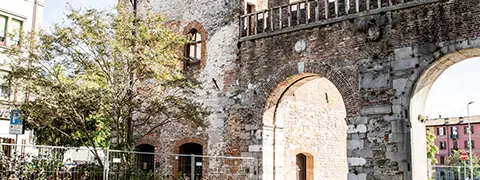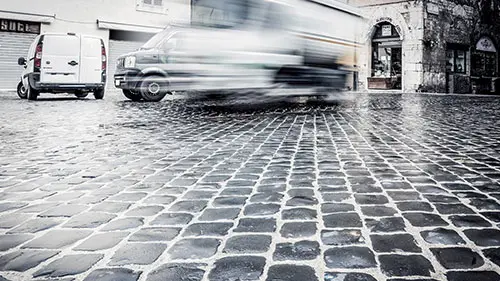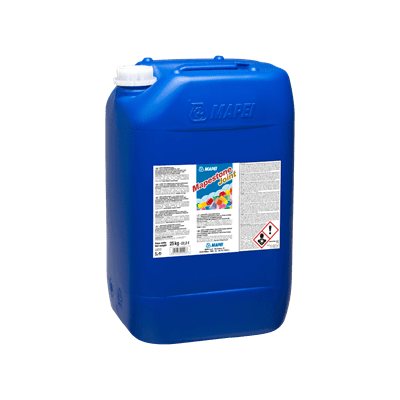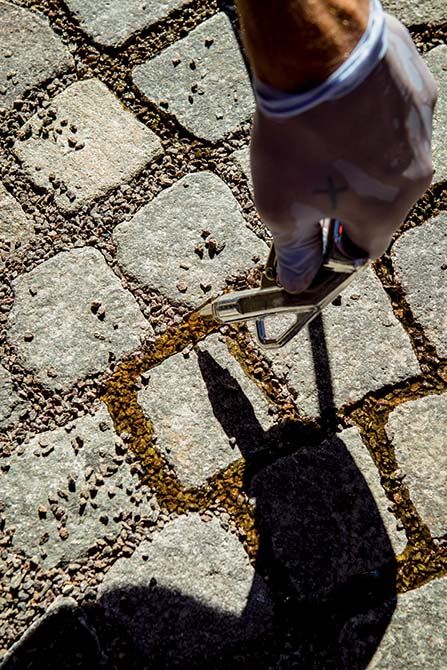
A new paving incorporating the city's coat of arms
Durability, urban design, and sustainability to resurface the porphyry roads in the city centre - to redevelop the highly trafficked Via Aquileia, Udine City Council specified reusing as many of the porphyry blocks from the previous paving as possible to create new strong, elastic, pervious and durable paving compliant with current applicable standards. MAPESTONE JOINT solvent-free polyurethane binder enabled the old blocks to be reinstalled in complete safety and to create an elastic, pervious road surface with no joints which would require only limited maintenance.
Durability, urban design, and sustainability to resurface the porphyry roads in the city centre.
Via Aquileia is a road in Udine (Northern Italy) that runs southwards towards the city of Aquileia.
Starting at the piazza just below the castle, it runs through the Porta Aquileia gate, an elegant reminder of the various city walls (five in total) built around the city of Udine over the centuries. It has always been an important thoroughfare for the city over the centuries and remains so today. In fact, this road is used every day by the intense city traffic, including public transport and lorries carrying goods to and from the city, leading to heavy, constant loads and stresses acting on the porphyry blocks which characterise the road surface.
PROJECT OVERVIEW
Within the overall framework of interventions planned by Udine City Council, maintenance of the porphyry paving in Via Aquileia and part of nearby Via Gemona is one of the most significant.
The old paving was deformed and had numerous hollows and dips, especially in the areas most stressed by traffic such as the bends in the road and at crossroads, as well as more localised unstable areas due to the blocks becoming detached from the substrate.
Which is why the City Council came up with a plan aimed at improving the durability of the road surface and reducing maintenance costs over the years by adopting non-traditional techniques to refurbish the paving.
The client, in this case Udine City Council, specified that the project also had to make use of as many of the existing blocks as possible, which had been installed in a traditional contrasting arch pattern using mainly 8 to 10 cm blocks, along with quite a large amount of smaller stones.
In view of these requirements, during the design phase it was decided to create an elastic, pervious surface compliant with the Italian standard UNI 11714-1:2018, class P9 (heavy traffic: urban roads; roads with bus lanes or prescribed lanes and highly trafficked roads; roundabouts and speed bumps), using polyurethane binder for the gaps between the reused porphyry blocks, which were to be placed on a loose-laid installation bed over an improved sub-layer made up of cement-bound mixed granular aggregate.
Apart from refurbishing the road surface, work also included upgrading the substrate, rebuilding the gutters along the sides of the road, repairing the manhole covers to bring them flush with the surface of the road and remarking the lanes, signs and indications on the surface of the road.
THE MAPEI SOLUTION FOR A HIGHLY TRAFFICKED ROAD SURFACE
To resurface Via Aquileia to class P9 (heavy traffic) according to UNI 11714-1:2018 standards using the old porphyry blocks, Mapei experts proposed MAPESTONE JOINT, a solvent-free polyurethane binder specially formulated to create safe, flexible, pervious and durable architectural stone paving, which has lower installation and maintenance costs as well as many other benefits, such as its aesthetic qualities. MAPESTONE JOINT has an amber-coloured finish, which means it blends in perfectly with the colour of the porphyry blocks and the crushed porphyry used to fill the gaps, and its overall effect is particularly pleasing to the eye.
MAPESTONE JOINT complies with the requirements of the REACH (the European Union’s Regulation on the Registration, Evaluation, Authorisation and Restriction of Chemicals) protocol and to the prescriptions and requirements of UNI 11714-1:2018 standards for polyurethane resins, which must guarantee product safety such as non-flammability, as well as safety while being transported, handled, stored and applied.
By complying with the prescriptions of UNI 11714-1:2018 standards, this means that MAPESTONE JOINT is suitable for class P9 paving and helps improve the overall durability of the paving. Stone paving correctly installed with MAPESTONE JOINT means that only limited maintenance will be required over the years, since it is particularly resistant to freeze-thaw cycles, de-icing salts, bad weather and the chemical action of contaminants from fuel and oil. Also, thanks to its elastic behaviour, expansion joints do not need to be included and paving is able to absorb the heavy loads and mechanical stresses caused by the passage of cars, buses and lorries without dangerous potholes forming due to settling and subsidence in the installation bed. Another advantage of using MAPESTONE JOINT is the speed at which paving can be put back into service, which can be reopened to traffic just 48 hours after installation at 20°C.
But the sustainability of this paving is not limited to the fact that it is pervious and drastically reduces overall site times, all to the benefit of residents and shops and businesses which can go back to using the paving after a very short downtime.
Via Aquileia has demonstrated that it is also possible to reduce waste of non-renewable materials such as precious, natural and durable stone which, if still intact, can be successfully used again.
In fact, the overall area of the newly-paved surface is more than 6,000 m2 and only 30% of that area needed new porphyry blocks, while blocks from the old paving were used for the remaining 70%, which received a new lease of life once they had been carefully selected, cleaned and tumbled.
The only exception was the coat of arms of the city in black and white, which was made from blocks of granite – using a special transparent version of MAPESTONE JOINT – set permanently into the paving to give a welcome to all those entering the city, right in front of the Porta Aquileia gate.
Grazia Signori. Architectural stone paving product line, Mapei SpA (Italy).






.jpg?sfvrsn=358f3e76_4)




.jpg?sfvrsn=428f3e76_4)
.jpg?sfvrsn=418f3e76_6)
.jpg?sfvrsn=338f3e76_6)
.jpg?sfvrsn=528f3e76_4)
.jpg?sfvrsn=578f3e76_4)
.jpg?sfvrsn=308f3e76_4)
.jpg?sfvrsn=328f3e76_4)
.jpg?sfvrsn=4e8f3e76_4)

